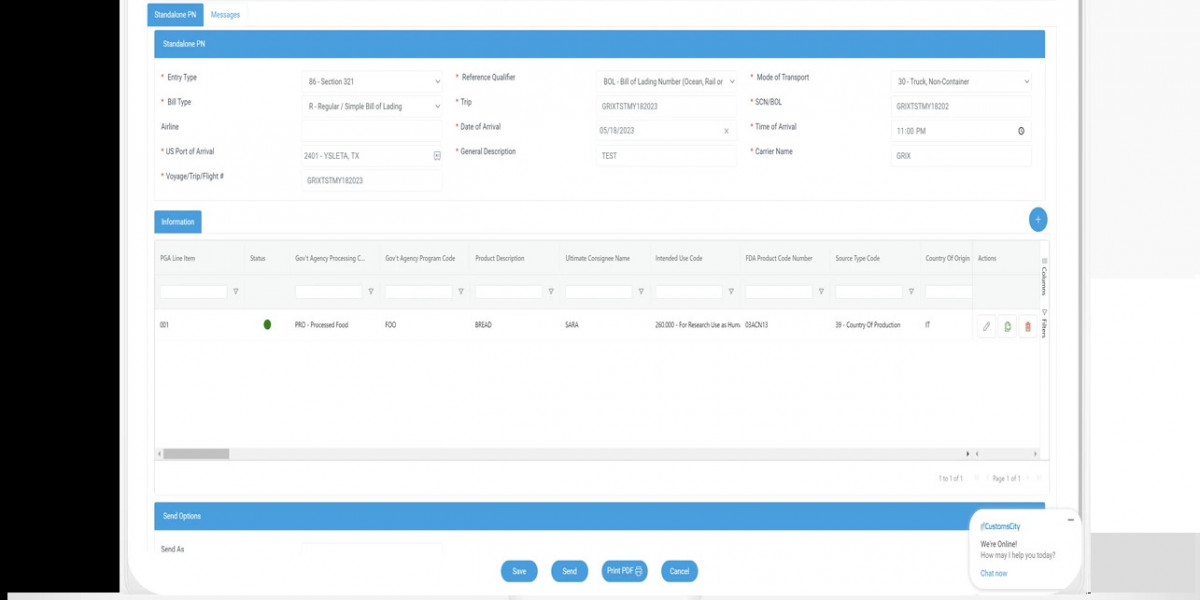Customs brokerage software streamlines the complex process of managing customs documentation, compliance, and communication between brokers, carriers, and regulatory authorities. It replaces manual tasks with automated workflows, reducing errors and speeding up clearance times. This software provides brokers with tools to efficiently handle customs entries, tariff classifications, and real-time monitoring for seamless international trade.Many solutions now offer cloud-based platforms accessible from any device, ensuring flexibility and constant availability. Integration capabilities with ERP, accounting, and transport management systems enhance data accuracy and operational efficiency. AI-driven features like automated invoice extraction and HS code prediction further simplify freight processing.By adopting customs broker software, companies can maintain compliance while improving throughput and reducing administrative burdens. Its ability to unify multiple functions within one dashboard makes it an essential asset for brokers navigating global logistics.
Key Features of Customs Brokerage Software
Customs brokerage software is designed to simplify and accelerate the compliance and documentation processes involved in international trade. It enhances accuracy, reduces manual workload, and supports integration with other business systems to improve overall logistics efficiency.
Automated Compliance Management
The software automates adherence to customs regulations by validating shipment details against current import/export laws. This includes automated checks for tariff classifications, licensing requirements, and duty calculations, minimizing errors and avoiding costly delays.It also manages filings for regulatory requirements such as Importer Security Filing (ISF) and Automated Export System (AES) reports. These automated compliance controls help ensure timely submissions and reduce the risk of penalties.By routinely updating customs rules and regulations, the software maintains up-to-date compliance without manual intervention. This keeps brokers aligned with complex and frequently changing trade laws, improving accuracy and operational speed.
E-Filing and Documentation
Customs brokerage software streamlines the preparation and submission of all required trade documents. This includes invoices, packing lists, bills of lading, and customs declaration forms.It automates document creation and leverages electronic filing with customs authorities to speed up the clearance process. Digitized documents reduce manual errors and improve data consistency across submissions.Many solutions incorporate AI-powered tools to extract, organize, and validate vast amounts of trade data. This reduces the need for manual data entry and enhances the speed and reliability of customs documentation.
Integration With Logistics and ERP Systems
Effective customs software integrates seamlessly with logistics tracking and Enterprise Resource Planning (ERP) platforms. This allows for real-time sharing of shipment statuses, inventory levels, and financial data.Such integration eliminates data silos and manual reconciliation, enabling end-to-end visibility across the supply chain. It supports automated updates to customs filings based on changes in shipment data or order details from ERP systems.By connecting with transportation management and warehouse systems, the software helps coordinate customs clearance with broader supply chain activities, improving efficiency and reducing delays.
Choosing the Right Customs Broker Software
Selecting customs broker software involves prioritizing flexibility, ease of use, and compliance assurance. The software must handle varying business needs, provide intuitive interfaces with strong support, and ensure robust security while adapting to regulatory changes.
Scalability and Customization
Customs brokerage software should scale with the size and scope of operations. It must accommodate growing transaction volumes and expanding geographic coverage without compromising performance or speed.Customization is critical to fit specific workflows, documentation formats, and reporting requirements. Software that allows configuration of features, integrations with existing logistics platforms, and automation of repetitive tasks offers tangible efficiency improvements.Businesses should consider cloud-based options for easier scaling and updates. On-premise solutions may require more complex upgrades but can provide tighter data control depending on company policies.
User Experience and Support
An intuitive, user-friendly interface reduces training time and errors. Clear navigation, streamlined workflows, and helpful prompts improve productivity.Reliable customer support is essential. Software vendors should provide timely assistance through multiple channels, including phone, email, and live chat. Access to training resources and regular updates also supports ongoing user proficiency.User experience extends to mobile compatibility and integration with customs authorities’ electronic filing systems. These features help brokers stay responsive and compliant in fast-moving environments.
Security and Regulatory Updates
Security features must safeguard sensitive shipment data and customer information. This includes encryption, role-based access controls, and secure data storage practices.Regulatory compliance is a moving target. Effective customs broker software automatically incorporates updates to tariffs, trade agreements, and customs regulations. This reduces the risk of delays, penalties, and costly errors.Vendors with proven compliance expertise and a history of timely regulatory adaptations provide greater confidence in maintaining operational integrity.








